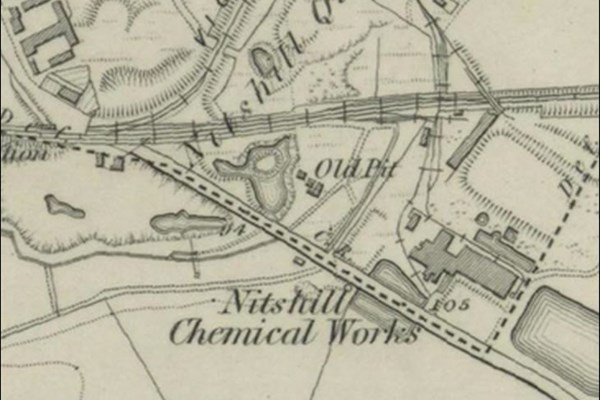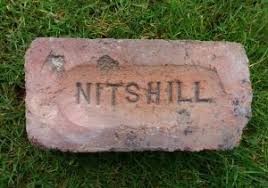Extraction Industries & Manufacturing
Brick Making and Nitshill

Nitshill Brick Works was located in what was then known as Peat Road, since renamed Cleeves Road, which before the days of coal had led to a boggy area where the villagers used to cut peat for their cottage fires. The existing Peat Road was built in the nineteen-twenties.
Brick making manufacturing was not new, indeed, it was brought to Britain by the Romans and after their departure, brick-making fell into decline, though many of the bricks from Roman buildings were later reused to build new properties. In the early-thirteenth century, bricks once more became fashionable as Flemish bricks were imported into England. This soon prompted domestic brick-making, though these were of poor quality and remained so until the early-fifteenth century, when a large number of Flemish and Dutch craftsmen came to settle in England and the quality of English bricks increased. It is recorded that all brickmakers travelled to building sites to make bricks from the local clays. Bricks varied in size depending on the moulds used by the travelling brickmakers who made them.
Suitable brick clay was dug from the ground and picked clear of any unwanted materials and then mixed to the right consistency for brick making. The clay was tempered by the weather and water and trodden under foot in open pits for two to three days before being thrown into wooden moulds to form the shape of the brick. The moulds were tapped and pricked to ensure that no air was trapped inside the clay, and any excess clay was removed by running a wire over the mould.
The clay bricks were then tuned out of the moulds onto flat barrows and taken to a level, south-facing field, where they were laid out to dry for two days and two nights. The damp bricks were regularly turned during that time to assist initial drying, then turned again on edge and stacked in rows, one on top of the other, to dry for between one and three months depending on the weather and time of year. When the bricks were dry enough, they were fettled (trimmed of blemishes) and stacked to form a kiln. Flues were set into the kilns, which were then filled with timber or peat. Once lit, the bricks were ‘fired’ for two to three whole days and then allowed to cool naturally; the kilns were then dismantled, and the bricks were sorted and stacked ready for use.

Brick colours depended on the chemical composition of the clay, the type of fuel used to fire the bricks, and the levels of oxygen present during the firing process. The presence of iron oxide gave the bricks a red colour, though very high levels of iron oxide gave a blue colour; limestone and chalk added to iron prior to tempering resulted in buff-yellow coloured bricks, and magnesium dioxide resulted in a deep blue colour; no iron or other oxides gave the bricks a white colour.
Brickmaking was regulated from the 1380s, initially by church guilds and later by specific guilds of tylers (the name for brickmakers). After the Great Fire of London in 1666, Charles I decreed that all new buildings in the city of London must be built of fireproof materials. As the Tylers’ Guild did not have enough craft members to undertake the work, it decided to relax its admission regulations and began to train people from the provinces to make bricks. This led to an explosion of brickmaking, with many hundreds of new brick makers and builders setting up businesses around England, usually as itinerant brickmakers. The brickmaking industry was further boosted by the introduction of mechanisation in the 1820s and with improved transport infrastructures, first canals and then railways. At that point, it was possible to establish permanent brickyards which could produce several thousands of bricks per day, and with a smaller workforce than was needed to produce bricks by hand. Variations in brick size were reduced by a statute which required that they should be twice as long as they were broad, normally being 8 by 4.5 inches or 9 by 4.5 inches. Within thirty years, most brickmakers used mechanised brick production. Traditional itinerant brickmakers could not compete with factories and small rural yards could not afford to invest in machinery. With only a handful of exceptions, the industry was now truly mechanised.
The transition from hand-moulding to the mechanized mass production led to the explosion of brick as a modern building material. By the early 1900s, brick had solidified its status as the preferred material for domestic and commercial buildings. In Nitshill, as with many other mining villages and towns, coal mining had resulted in great bings of waste which were used to feed the local brick works for many years.

